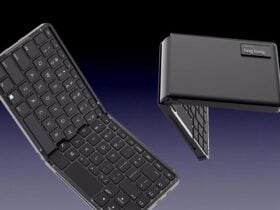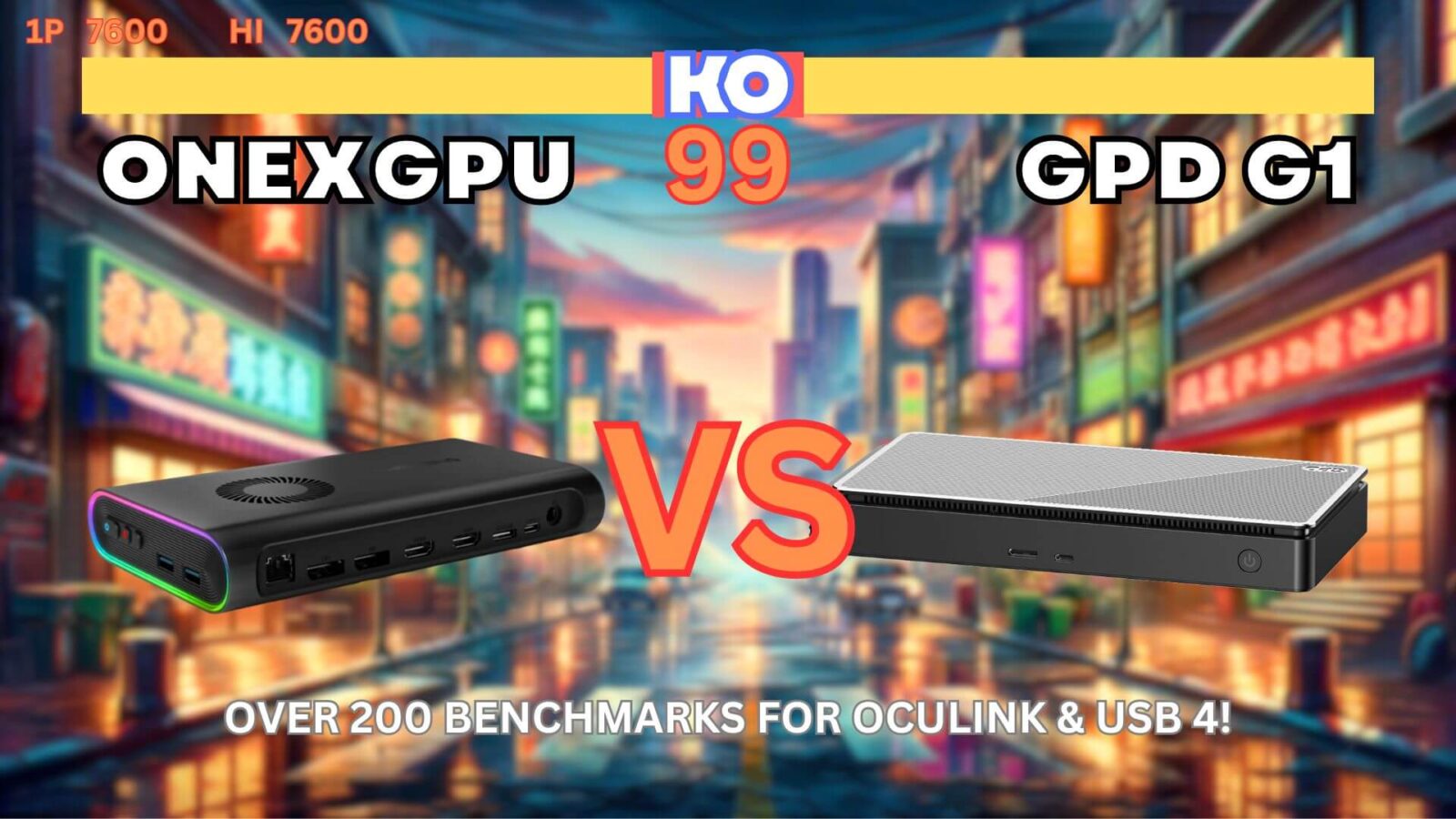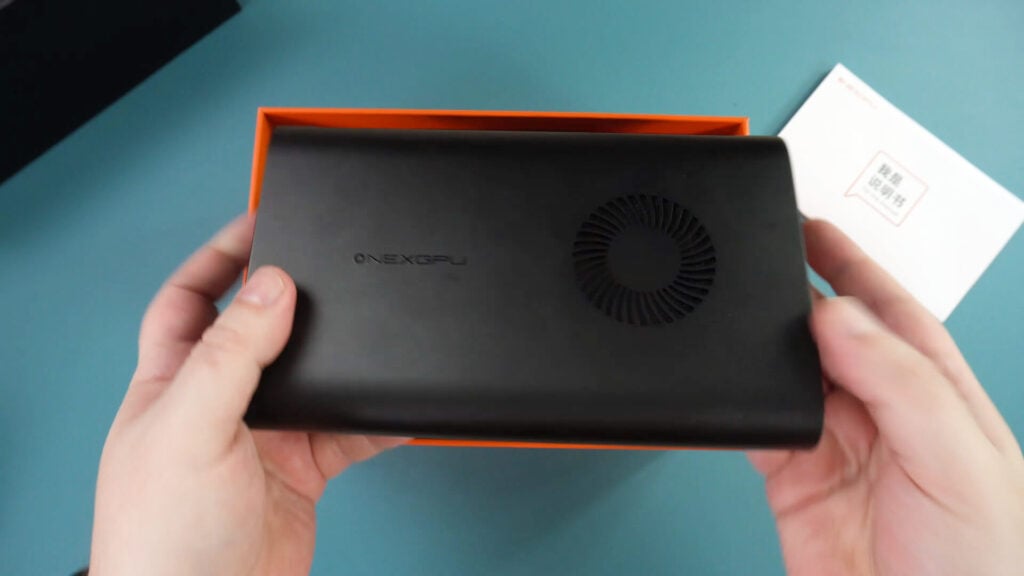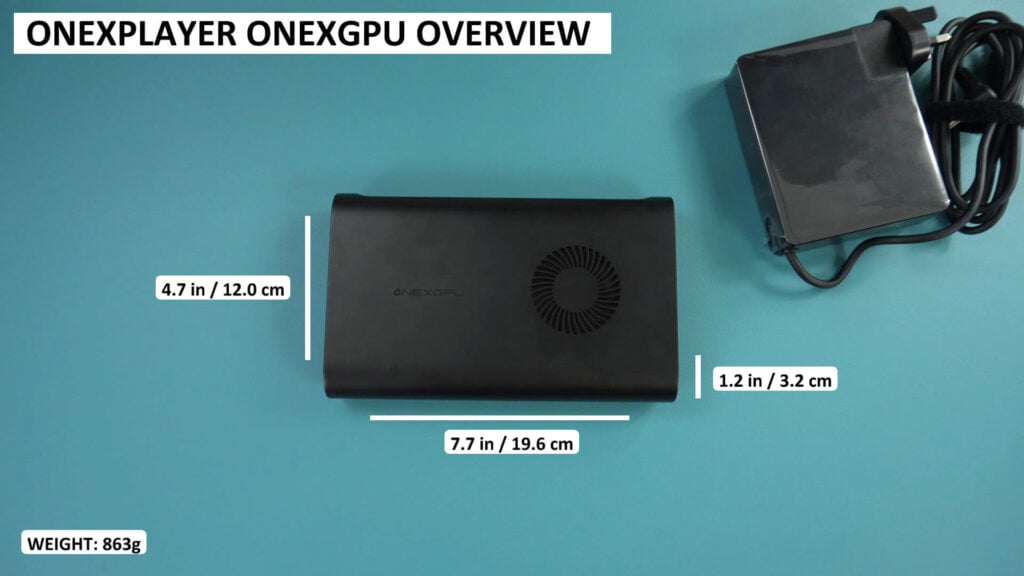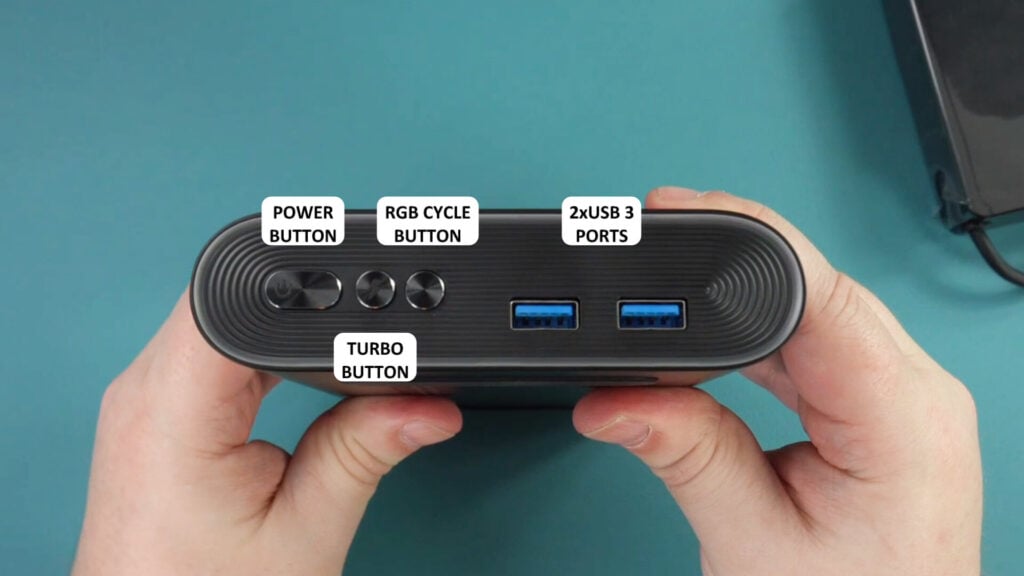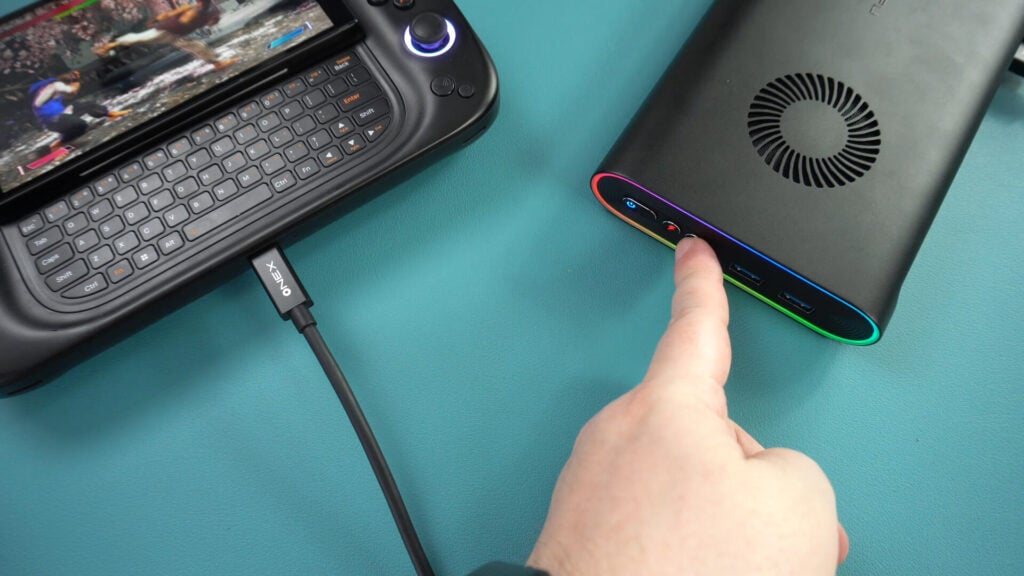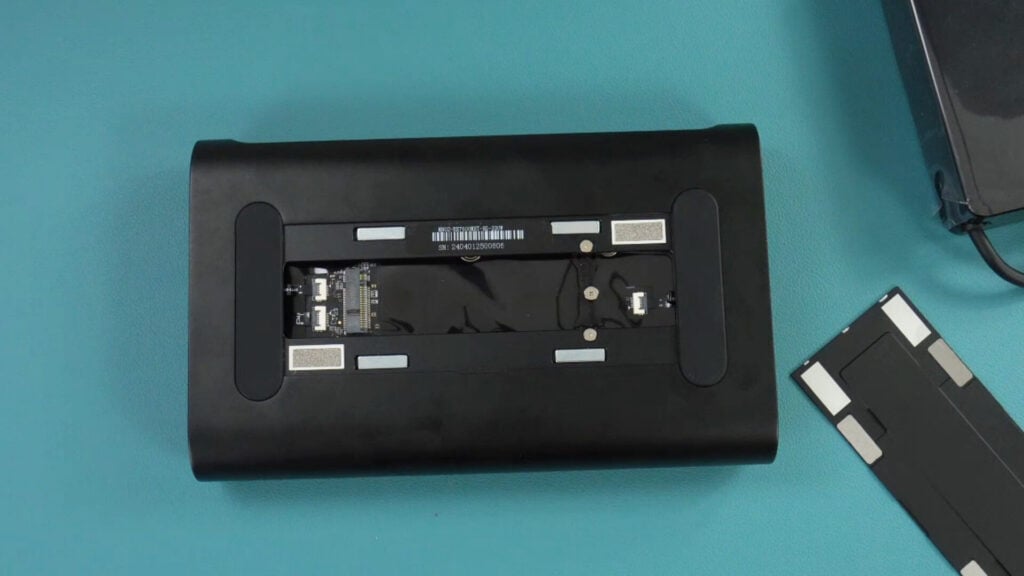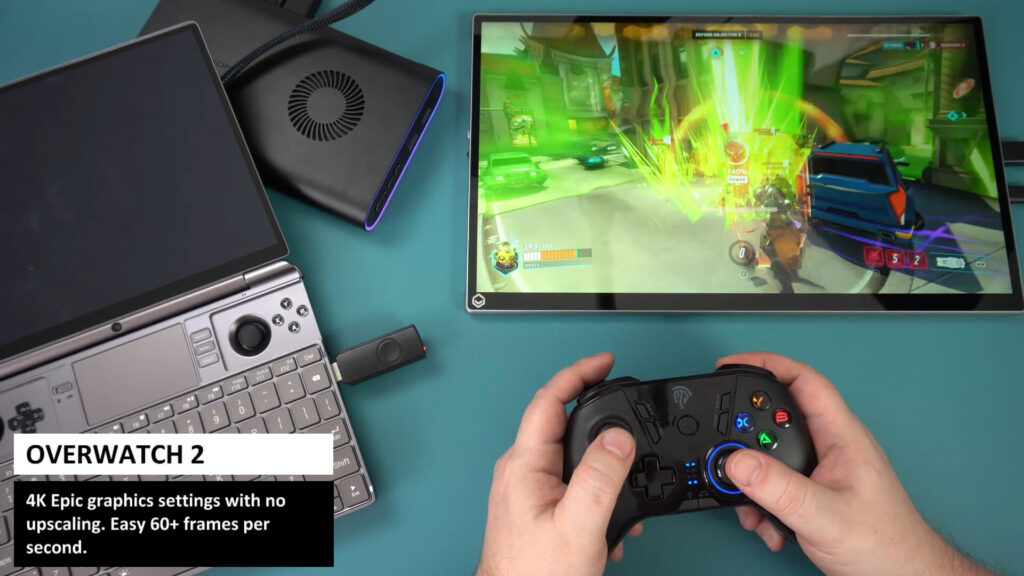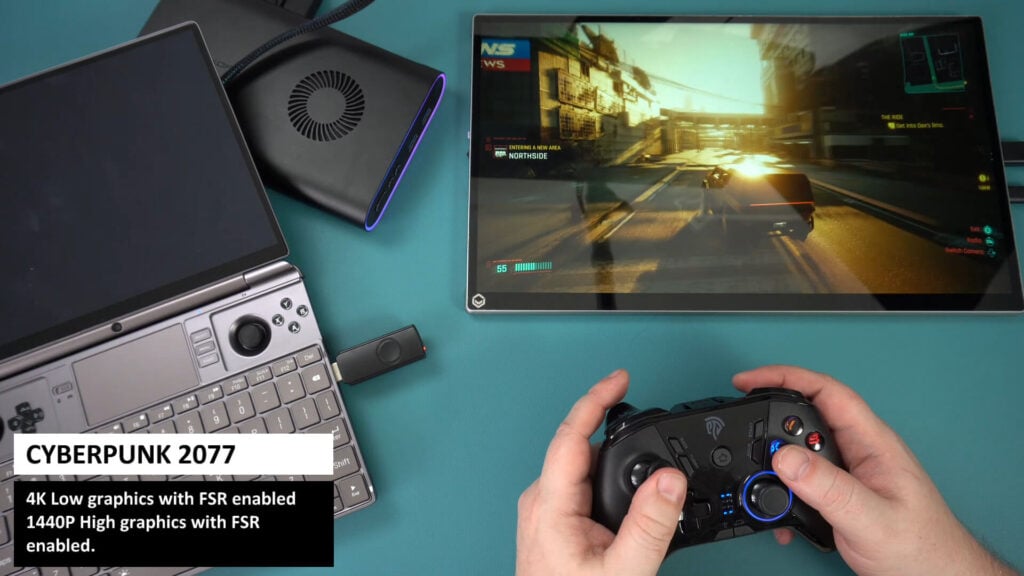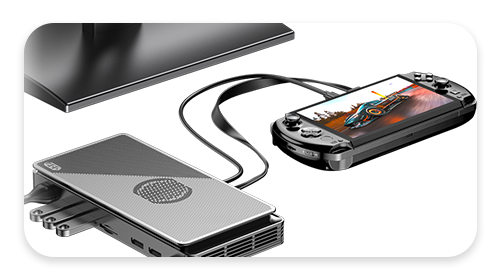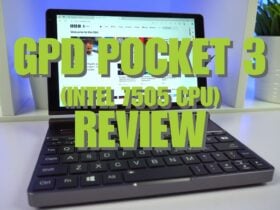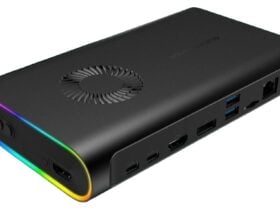ONEXPLAYER ONEXGPU Review
-
Design
(5)
-
Build Quality
(4.5)
-
Performance
(4.5)
-
Features
(5)
Summary
The ONEXPLAYER ONEXGPU is a versatile and powerful eGPU option that stands out for its internal SSD expansion, robust connectivity options, customizable RGB lighting, and excellent OcuLink performance.
Overall
4.8User Review
( votes)Pros
- Great OcuLink performance
- Internal SSD Storage Expansion
- Connectivity Options
- 300W Power Supply Features
- RGB Lighting
Cons
- Power supply is large and over 700 grams.
- Slightly slower performance over USB than the GPD G1
We compared the ONEXPLAYER ONEXGPU with the GPD G1 docking station and performed over 200 benchmarks for OcuLink & USB performance. Check out our ONEXPLAYER ONEXGPU review to see who comes out on top!
ONEXPLAYER ONEXGPU review video
Unboxing the ONEXPLAYER ONEXGPU
We start the ONEXGPU review with a brief unboxing. First out of the box we have a user guide. It is in English and Chinese languages. Next there is the ONEXPLAYER ONEXGPU itself, we will show it in more detail in a moment.
Underneath is an enormous 300W power supply. We will include the correct plug adapter for your country. And last but not least is a USB 4 cable. Please note an OcuLink cable is not included.
ONEXPLAYER ONEXGPU
Next in out ONEXGPU review we take a closer look at the eGPU docking station itself. The ONEXPLAYER ONEXGPU measures around 7.7 in x 4.7 x 1.2 in (19.6 x 12.0 x 3.2 cm) and weighs 863g.
On the right side is a power button, turbo button and RGB lighting button. There are two USB 3 ports to finish the side layout.
Pressing the RGB button switches to the next pattern in the sequence of lighting on both the left and right sides.
On the back is a gigabit ethernet port followed by two DisplayPorts and HDMI for up to quad monitor support. There are OcuLink and USB 4 ports for data and the power port.
The bottom has a removable cover where you can install a NVMe stick to expand your storage. It is very easy to do, simply remove the screw, match the keying up and insert it at a slight angle, push down, fit the screw, close the lid and you are good to go.
A brief mention for the power supply, it’s an absolute beast. It alone weighs 725g but does supply 300W of power for use with the dock as well as up to 100W charging of devices. A nice touch is you can remove this part and plug in a kettle lead if you don’t want this hanging off the wall directly. It is probably best if you do use a lead.
ONEXPLAYER ONEXGPU Technical Specifications
As part of our ONEXGPU review we cover the technical specifications as well as our own tests for power consumption, fan noise and thermals.
| GPU | AMD Radeon RX 7600M XT RDNA 3.0, 32 compute units up to 2300Mhz |
| RAM | 6GB GDDR6 |
| STORAGE | m.2 2280 SSD PCIE 3.0 NVMe SSD |
| I/O | USB-C 4.0, USB-A x2, HDMI x2, DisplayPort X2, OcuLink, Gigabit Ethernet |
| SIZE | 7.7 x 4.7 x 1.2 in (19.6 x 12.0 x 3.2 cm) |
| WEIGHT | 863g, with power supply 1.58kg |
In our power test we ran the Street Fighter VI benchmark at 4K Highest graphics settings, on the Win MAX 2023 via Oculink and got a peak power usage of 167 W. And 21 W whilst idle on the desktop.
In our fan and thermals test, also while running Street Fighter VI benchmark, we got a highest fan noise of 72db and highest temperature of 60 °C.
Benchmarks
Now for the main part of this ONEXGPU review, the benchmarks! For these benchmarks we spent many hours running benchmarks across two devices; the AYANEO Slide 7840U, and GPD Win MAX 2 2023 7640U model. For the AYANEO Slide we tested with a USB 4 connection with both an internal and an external 4K monitor. And the same for the WIN MAX 2 23 but repeated with OcuLink, and again repeated with the GPD G1 eGPU docking station for comparison. There were over 200 benchmarks!
We have combined the results into three bar charts for each test. Comparing OcuLink performance on the Win MAX 23, and comparing USB 4 performance on both devices. We are not comparing handhelds performance as its two different CPUs, this is an eGPU comparison. We have made a spreadsheet available here if you want to compare the results yourself.
And finally, we have not used the ONEXGPU turbo button in these benchmarks. We did see some occasional minor increases in performance on a couple of benchmarks when enabled, but for many tests the scores were identical.
3DMark
Our first benchmark is for 3DMark which tests the CPU and GPU performance. We ran Time Spy, Night Raid and Fire Strike tests.

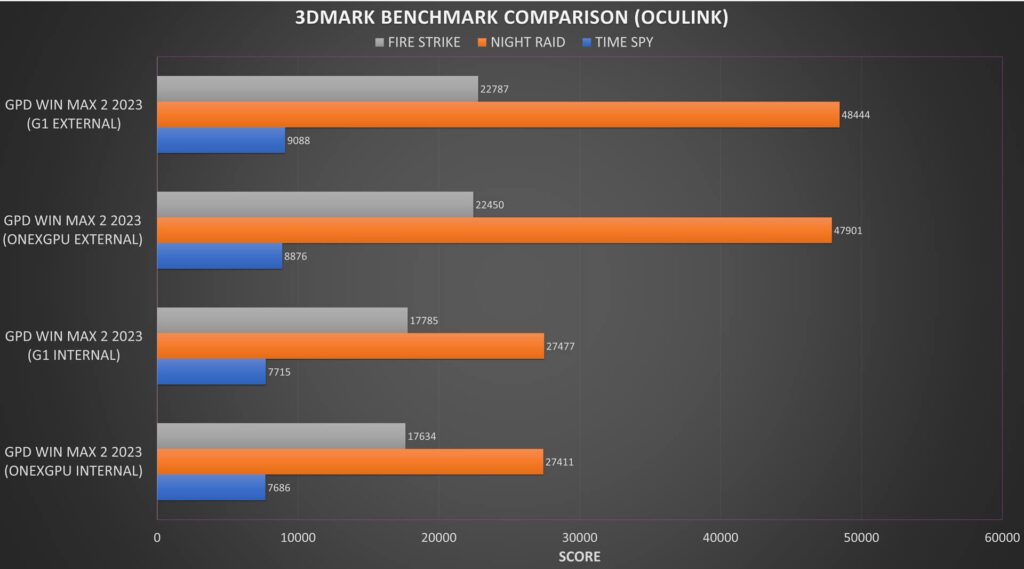

On the OcuLink results we see essentially identical scores give or take a few frames. For the USB 4 tests, the AYANEO saw overall slightly higher performance on the GPD G1. And for the GPD Win Max 2 2023 we saw noticeably higher scores on a few results and closer scores on others.
Forza Horizon 5
We are running Forza Horizon 5 on the Very Low graphics settings. In our OcuLink results we see almost identical scores across all of the benchmark results.
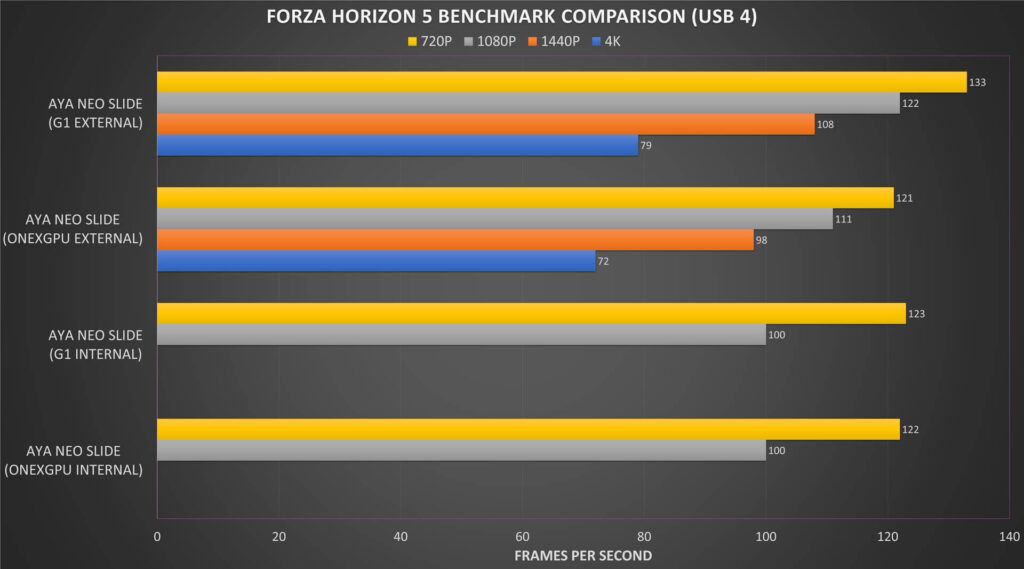

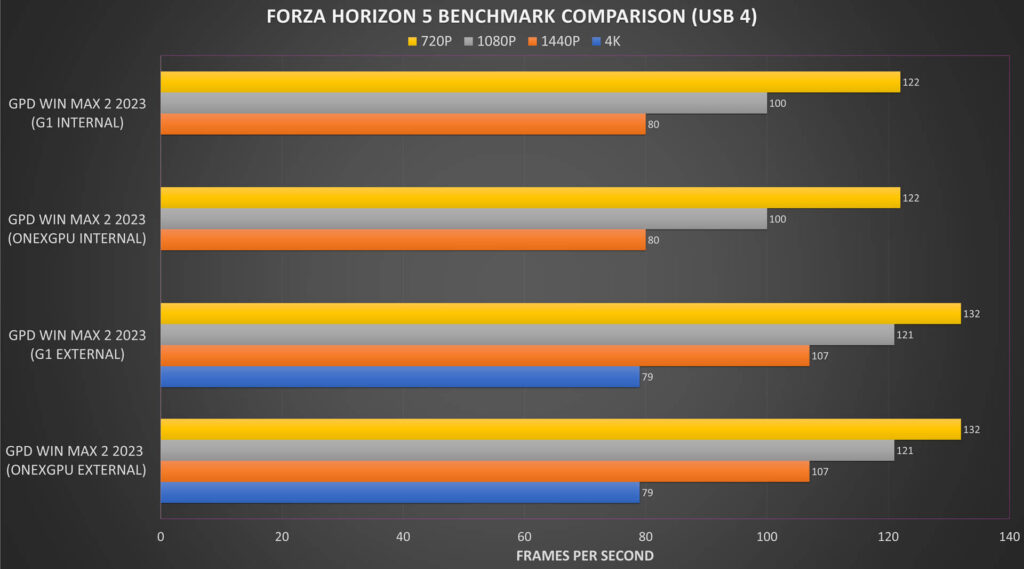
In our AYANEO Slide USB 4 results, we see the G1 outperform on External display and have near identical scores on Internal. And for the Win Max 23 we see near identical scores across the board.
Shadow of the Tomb Raider
We are running Shadow of the Tomb Raider on the Lowest graphics settings.

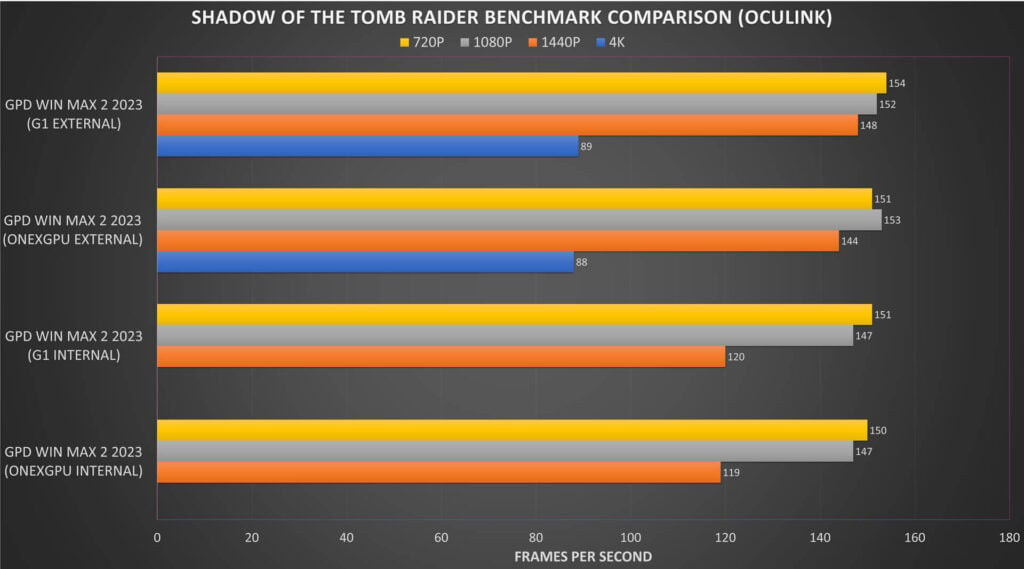
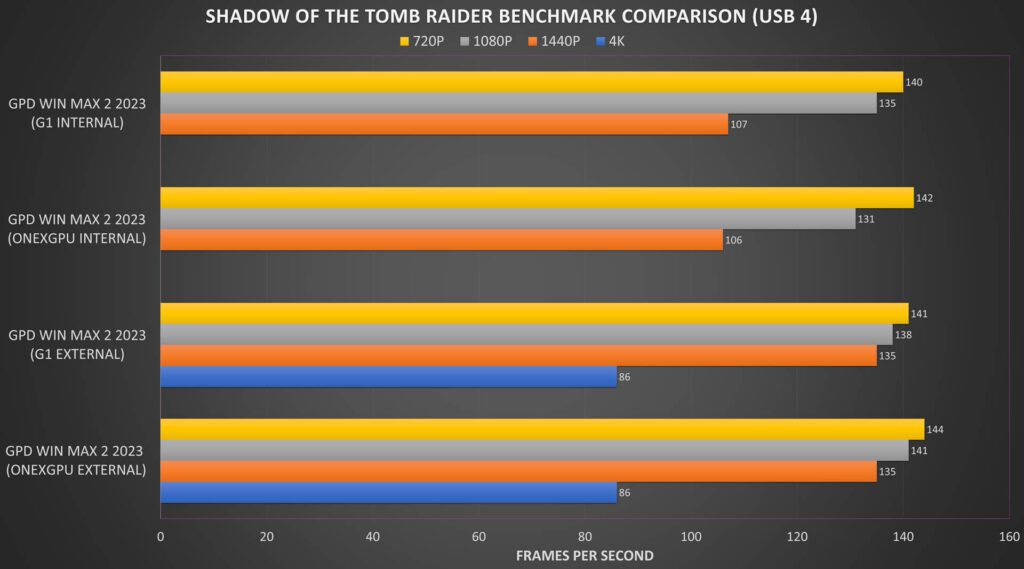
In our OcuLink results we see the usual bunching up of frames per second at 720, 1080p and 1440P on external monitor. And at 4K a considerable drop in performance on both external graphics cards. For the AYANEO on USB, we see noticeable differences in performance on external monitor with the G1 taking the lead. However, internal, we see a much closer range of results. And for the Win MAX 23 the results are near identical compared to each other. This game always gives us interesting results for comparison across different devices.
Call of Duty: Modern Warfare III
Next is Call of Duty Modern Warfare III on the Minimal graphics settings with no FSR enabled.
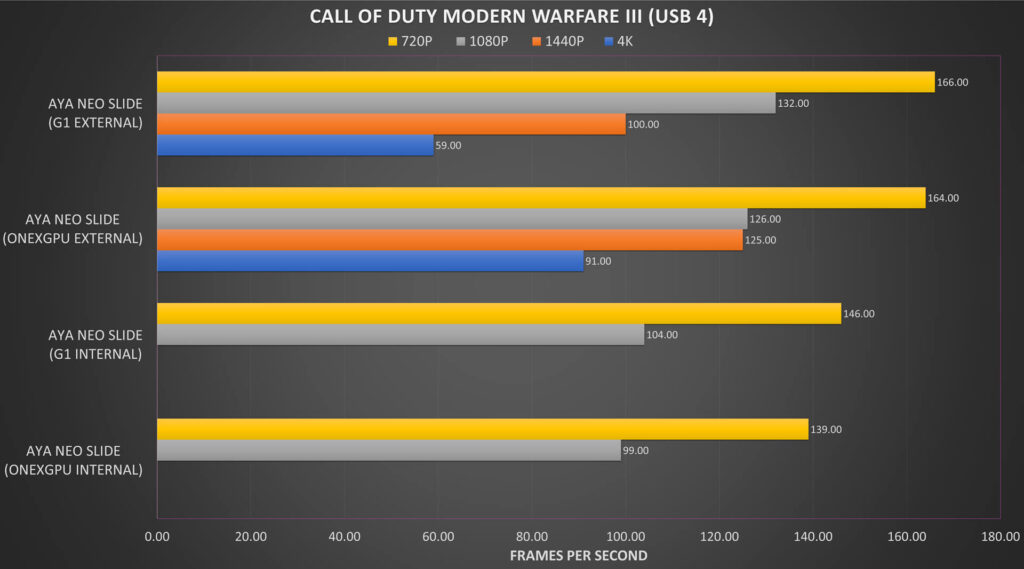

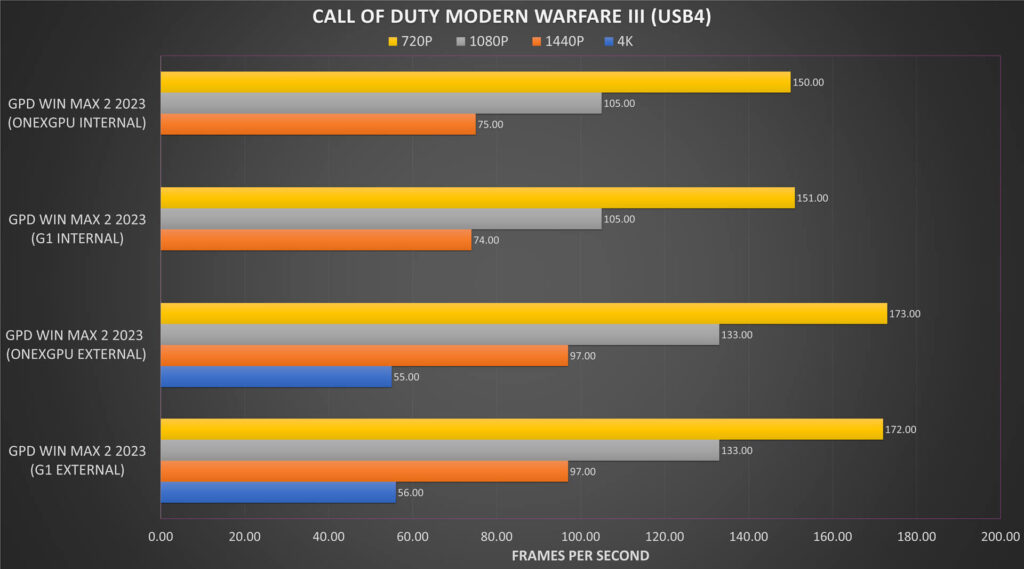
On Oculink we get the same scores across all the tests. For the AYANEO Slide we see the G1 take the lead at low resolution, but as we go higher the ONEXGPU takes the lead. And for the WIN MAX 23 the results are essentially the same on both eGPUs.
Street Fighter VI
Our final benchmarks are for Street Fighter VI on the highest graphics settings to really stress the eGPUs.

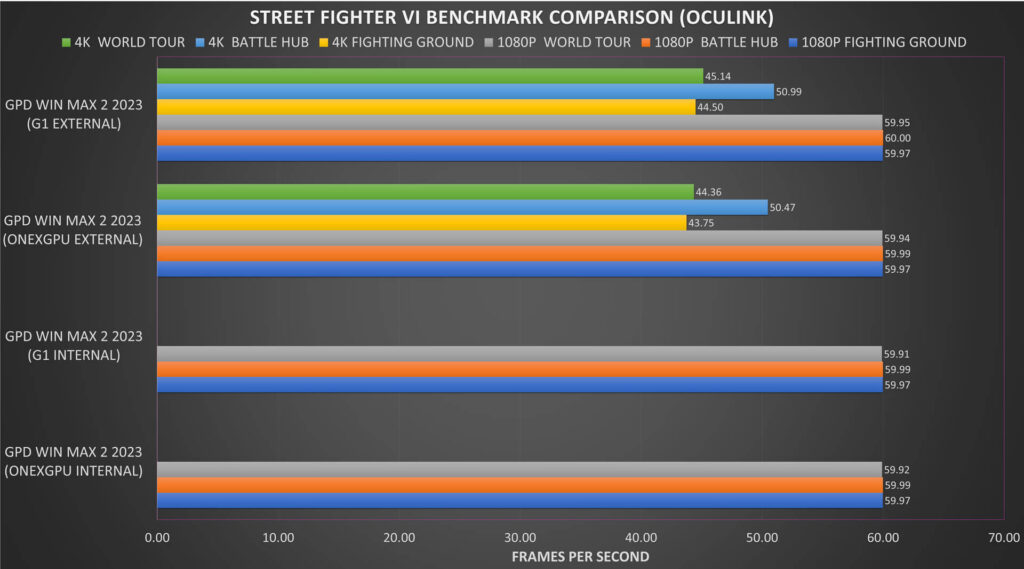

In the Oculink results we essentially get 60 FPS on Internal display at 1080P, and roughly the same results on External display. This pattern mostly repeats on the AYANEO Slide with similar scores on both eGPUs. The Win MAX 23 saw similar scores, nothing out the ordinary here.
Benchmark summary
A brief summary for the ONEXGPU review benchmark results. Across the benchmarks we saw mostly identical scores for benchmarks with OcuLink. With USB 4 benchmarks we do see some differences in performance, and it is generally in favour of the GPD G1. And using an external monitor instead of internal while using USB will give a noticeable increase in performance, this is due to the data only travelling in one direction from handheld to eGPU and then to the monitor.
Overall I would say the GPD G1 is very slightly faster in performance over USB only but there’s not much in it.
Final Thoughts
We will finish our ONEXGPU review now with our final thoughts while showing some games running on the AYA NEO Slide via USB and Win Max 2 23 via Oculink. We are aiming for 60 and above frames per second with the best resolution and graphics settings we can get. You can of course tailor the settings to your own preference and these are just examples.
Overall the ONEXPLAYER ONEXGPU does very well as an eGPU. For Oculink performance we saw near identical benchmark results across all tests when compared with the G1. We saw varying performance with USB only connection, I would say the GPD takes the lead here but not by massive margins.
In terms of features, the ONEXGPU eGPU docking station leads over the G1. Firstly we have the internal SSD storage which is a great feature. Having easy access to more storage is never a bad thing. The ONEXGPU also has one additional HDMI port, and has an ethernet port, something which the G1 surprisingly misses. But the G1 does have a SD card reader which the ONEX lacks, as well as one additional USB port.
In terms of size, the G1 is slightly larger, but it does have the advantage of the PSU being internal, only requiring a cable to power it. The ONEXGPU requires that beast of a power supply which, combined with the eGPU itself, weighs 1.5kg. The G1 and a cable combined weight is around 986g This could be a crucial decider if portability is a requirement.
Pricewise they are around the same price give or take a couple of dollars, so there’s no outright winner there. Personally I would say the ONEXGPU is the better eGPU docking station in terms of value for money and features, while it slightly lacks in performance when using USB only, it does equal the G1 when using Oculink.
As a note, the latest handhelds are supported, providing they they have OcuLink or USB 4 support. This also includes the new ROG Ally X which now has a USB 4 port.
Which one would you buy? The ONEXPLAYER ONEXGPU or GPD G1? Let us know in the comments why as we are always interested to read the reasons when two similar products are available.
You can learn more about and buy the ONEXPLAYER ONEXGPU here.
Thanks for reading our ONEXGPU review, we hope you have found it useful. Let us know in the comments if you have any questions.



